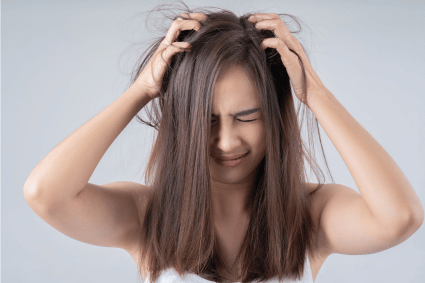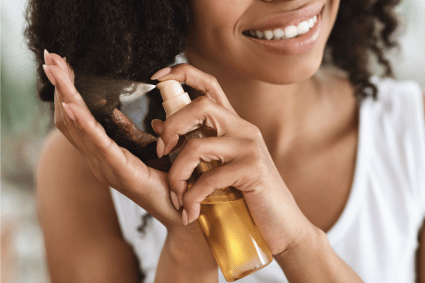
Understanding Dry Hair: Causes and Symptoms
Dealing with dry hair is a common problem, and understanding its causes is essential for proper care and treatment. Environmental factors are contributory to the condition of your hair. Conditions such as prolonged sun exposure, low humidity, and cold winds can strip the hair of moisture, leading to dryness. Air conditioning and heating systems can make this problem worse by producing an environment that can cause dry hair.
Hair treatments that contain certain chemicals are another significant cause of hair damage. Frequently coloring, bleaching, or using relaxers can affect the hair’s natural oils. These chemicals can disrupt the hair’s moisture balance, making it prone to brittleness and breakage. Therefore, those using regular chemical processing must find effective methods on how to treat dry hair to mitigate potential damage.
Poor hair care practices also cause a deterioration in the health of your hair. Overwashing with harsh shampoos can deplete the natural oils that nourish and protect hair. Inadequate conditioning and neglecting having a regular trim can lead to split ends and overall dullness. Therefore, establishing a proper hair care regimen is vital for maintaining hydration and ensuring damaged hair repair.
Understanding the symptoms of dry hair can help with early intervention. Key indicators include brittleness, where hair breaks easily, and split ends, which can occur when the hair shaft frays. A dull appearance is another sign that the hair lacks moisture and vitality. Recognizing these symptoms and taking proactive steps to explore different ways to treat dry hair and prevent further damage. Seeking immediate care when symptoms appear can fortify the hair against more severe issues down the line.

Essential Oils and Hair Treatments for Moisture
Dry hair can be a persistent issue that many women face, but using certain hair oils and treatments can significantly help in restoring moisture and vitality. Some of the most effective oils are argan oil, coconut oil, and jojoba oil, each offering unique properties that contribute to overall hair health.
Argan oil is renowned for its deep moisturizing capabilities and high content of essential fatty acids, making it an excellent option for damaged hair repair. This oil penetrates the hair shaft, providing hydration and helping to reduce frizz.
Coconut oil is another powerhouse when it comes to treating dry hair. Its small molecular structure allows it to penetrate deeply, providing much-needed moisture and reducing protein loss in the hair. This natural remedy is beneficial for those seeking to treat dry hair, as it can also enhance shine and softness. For best results, apply coconut oil as a pre-wash treatment or leave it on overnight and wash out in the morning.
Jojoba oil is structurally similar to scalp sebum and helps to regulate oil production and nourish dry hair. When looking for oils for healthy hair, jojoba is an excellent choice, as it hydrates without weighing the hair down. Regular application can lead to improved moisture retention and overall manageability.
In addition to oils, deep conditioning treatments and hair masks can significantly aid in repairing dry, damaged hair. These treatments are designed to deliver intense moisture, making them perfect dry hair remedies. Look for masks that contain ingredients like shea butter, honey, or silk proteins to boost hydration.
By integrating these oils and treatments into your hair care regimen, you can effectively combat dryness and enjoy healthier, shinier hair.

Choosing the Right Shampoos and Conditioners
When facing the challenges of how to treat dry hair, choosing the appropriate shampoos and conditioners is paramount. Shampoos strip away dirt and oil from the scalp and hair; hence, choosing sulfate-free formulas is advisable. Sulfates can exacerbate dryness by removing essential natural oils, leading to further damage. Instead, look for moisturizing shampoos containing hydrating ingredients such as glycerin or aloe vera, which help to retain moisture and restore shine to dry hair.
As well as choosing sulfate-free options, it is essential to find conditioners specifically designed for the repair of dry, damaged hair. These products generally contain ingredients like shea butter, coconut oil, or argan oil—powerful hair oils for healthy hair that nourish and repair. Avoid conditioners with alcohol and mineral oil, as they can dehydrate and weigh down hair, preventing you from achieving healthy, hydrated locks.
To get the best from these products, it is crucial to apply them properly. After shampooing, apply conditioner generously; focus on the ends of the hair where dryness is often most pronounced. To ensure deep penetration, leave the conditioner in for a few minutes. Then, if it is possible, use a warm towel or heat wrap to improve absortion.
By following these steps, you will see noticeable improvements to the moisture levels and texture of your hair. You should also consider incorporating deep conditioning treatments or masks once a week to boost hydration and strength.
Taking note and acting on these suggestions for dealing with dry hair and by the careful selection and application of shampoos and conditioners can significantly improve the overall health and appearance of your hair. Having a consistent approach to your hair care routine will have lasting results in restoring moisture and vitality to dry hair.

Best Practices and Prevention Measures for Dry Hair Care
Managing dry hair effectively requires an all-round approach that combines both preventive measures and restorative practices.
Reducing heat exposure is one of the basic methods for treating dry hair. Excessive heat from styling tools can strip moisture from the hair, leading to damaged hair repair challenges. To lessen how much heat your hair is exposed to, consider reducing the use of blow dryers, curling irons, and straighteners. If heat styling is unavoidable, always apply a heat protectant spray beforehand to shield the hair from potential damage.
Another effective method of dealing with dry hair is to adopt protective hairstyles. Styles that tuck and hide the ends of your hair, such as braids or buns, can help minimize breakage and retain moisture.
Dietary considerations play a significant role in hair health as well. A well-balanced diet rich in vitamins and minerals—particularly omega-3 fatty acids, biotin, and vitamins A and E—can contribute to overall hair strength and hydration. Foods such as salmon, nuts, seeds, and leafy greens should be incorporated as part of a comprehensive approach on how to get rid of dry hair.
If you are interested in more DIY approaches to dry hair remedies, a simple mixture of honey and olive oil can work wonders. Apply this combination to damp hair for a deep conditioning treatment that nourishes and revives dry strands.
Having regular trims to remove split ends is essential for maintaining a healthy appearance and preventing further damage.
Implementing these best practices can empower you with the necessary tools to keep your hair hydrated, healthy, and free from breakage.
Product Recommendations
Organic Argan Oil
Organic Fractionated Coconut Oil
Pure Jojoba Oil
Hydrating Mask for Dry Hair
Moisterizing Shampoo with Argan Oil for Dry/Brittle Hair
Moisterizing Conditioner with Argan Oil for Dry Hair
Thermal Protectant Spray
Disclosure: This post may contain sponsored links. www.lookladies receives a small commission if you decide to make a purchase through our link; this adds no extra cost to your purchase. This commission helps to fund the running and upkeep of this website. Many thanks for your support, the Look Ladies team.
